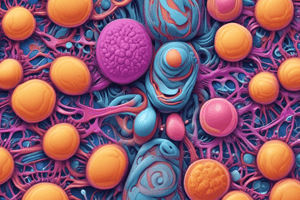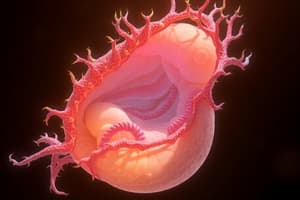Podcast
Questions and Answers
Which mutation is associated with the condition known as aniridia?
Which mutation is associated with the condition known as aniridia?
- Mutations in NKX2.2
- Mutations in BMP4
- Mutations in SOX2
- Mutations in PAX6 (correct)
What is the main defect associated with cyclopia?
What is the main defect associated with cyclopia?
- Underdevelopment of the forebrain (correct)
- Segmentation of craniofacial structures
- Presence of multiple eyes
- Complete absence of eyes
Which of the following is NOT a structure associated with lateral plate mesoderm?
Which of the following is NOT a structure associated with lateral plate mesoderm?
- Neural tissues (correct)
- Skeletal muscles
- Cardiovascular system
- Limbs
Which part of the ear functions as the primary sound collecting organ?
Which part of the ear functions as the primary sound collecting organ?
Coloboma results from defects in which developmental process?
Coloboma results from defects in which developmental process?
During which days of gestation may the loss of midline tissue occur, leading to cyclopia or synophthalmia?
During which days of gestation may the loss of midline tissue occur, leading to cyclopia or synophthalmia?
Which of the following options correctly describes a defect associated with synophthalmia?
Which of the following options correctly describes a defect associated with synophthalmia?
What type of cells are multipotent stem cells primarily responsible for differentiating into?
What type of cells are multipotent stem cells primarily responsible for differentiating into?
Which type of cleft lip extends into the nose?
Which type of cleft lip extends into the nose?
What structure separates the auricle from the tympanitic cavity?
What structure separates the auricle from the tympanitic cavity?
Which of the following structures does not derive from the 1st pharyngeal cleft?
Which of the following structures does not derive from the 1st pharyngeal cleft?
Which type of cleft involves both the lip and jaw, extending to the incisive foramen?
Which type of cleft involves both the lip and jaw, extending to the incisive foramen?
What is a common feature of external ear defects?
What is a common feature of external ear defects?
Which nerve is responsible for the general sensory innervation of the anterior two-thirds of the tongue?
Which nerve is responsible for the general sensory innervation of the anterior two-thirds of the tongue?
What is the primary origin of the muscle fibers found in the tongue?
What is the primary origin of the muscle fibers found in the tongue?
Which structure innervates the epiglottis and the extreme posterior part of the tongue?
Which structure innervates the epiglottis and the extreme posterior part of the tongue?
What structure is innervated by the chorda tympani branch of the facial nerve?
What structure is innervated by the chorda tympani branch of the facial nerve?
Which nerves provide general sensory innervation to the root of the tongue?
Which nerves provide general sensory innervation to the root of the tongue?
Which cranial sensory ganglia are associated with ectodermal thickenings known as epipharyngeal placodes?
Which cranial sensory ganglia are associated with ectodermal thickenings known as epipharyngeal placodes?
What is the primary derivative of the first pharyngeal pouch?
What is the primary derivative of the first pharyngeal pouch?
What structures are primarily formed from the second pharyngeal pouch?
What structures are primarily formed from the second pharyngeal pouch?
Which pharyngeal arch structures are primarily associated with the development of the tongue?
Which pharyngeal arch structures are primarily associated with the development of the tongue?
What happens to the remnants of the second, third, and fourth pharyngeal clefts during development?
What happens to the remnants of the second, third, and fourth pharyngeal clefts during development?
Which of the following structures is NOT derived from the first pharyngeal arch?
Which of the following structures is NOT derived from the first pharyngeal arch?
What characterizes the caudal neuropore during embryonic development?
What characterizes the caudal neuropore during embryonic development?
How many pairs of pharyngeal pouches are present in a human embryo?
How many pairs of pharyngeal pouches are present in a human embryo?
What characterizes the face of a newborn with a midline cleft lip?
What characterizes the face of a newborn with a midline cleft lip?
Which components does the internal ear originate from?
Which components does the internal ear originate from?
What is the main function of the membranous labyrinth in the internal ear?
What is the main function of the membranous labyrinth in the internal ear?
Which of the following accurately describes the origins of the middle ear?
Which of the following accurately describes the origins of the middle ear?
During which week of development does the internal ear begin to form?
During which week of development does the internal ear begin to form?
What is NOT a component of the external ear?
What is NOT a component of the external ear?
Which statement about the embryonic development of the ear is incorrect?
Which statement about the embryonic development of the ear is incorrect?
The distance between which structures is noted in the normal face of an embryo at six weeks?
The distance between which structures is noted in the normal face of an embryo at six weeks?
Flashcards are hidden until you start studying
Study Notes
Paraxial Mesoderm and Eye Development
- Mutations in the PAX6 gene lead to aniridia, a condition characterized by the absence of the iris.
- Cyclopia involves the presence of a single eye, while synophthalmia refers to fused eyes, both resulting from midline tissue loss during embryonic development (days 19-21 of gestation).
- Loss of midline tissues can result in forebrain underdevelopment and issues with the frontonasal prominence.
Pharyngeal Arches and Pouches
- The human embryo has four pairs of pharyngeal pouches, with a fifth being rudimentary.
- First pharyngeal pouch develops into the tubotympanic recess, which becomes the middle ear cavity and the auditory (eustachian) tube.
- Second pharyngeal pouch forms the palatine tonsils through epithelial proliferation.
- The tongue develops from segments of multiple pharyngeal arches: the body (1st arch - trigeminal nerve) and the root (3rd & 4th arches - glossopharyngeal and vagus nerves).
Structures of the Ear
- The ear comprises three main regions: external ear, middle ear, and internal ear.
- External ear: Originates from the 1st pharyngeal cleft and is separated from the tympanic cavity by the tympanic membrane.
- Middle ear: Contains ossicles (malleus, incus, stapes) derived from pharyngeal arches; assists in conducting sound.
- Internal ear: Arises from the otic vesicle during the 4th week; consists of the cochlear duct for hearing and balance components.
Common Ear Defects and Implications
- External ear abnormalities are frequent, associated with both common and rarer chromosomal syndromes.
- Anomalies can range from minor defects to major deformities impacting auditory function or appearance.
Studying That Suits You
Use AI to generate personalized quizzes and flashcards to suit your learning preferences.




